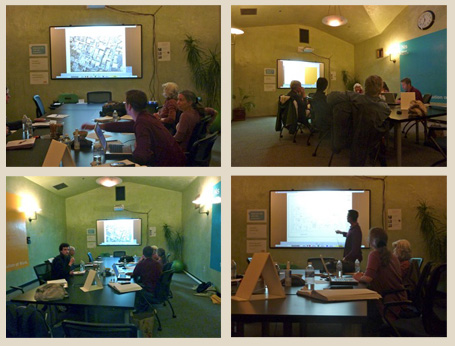About Cohousing
Cohousing is a type of intentional, self-selected community composed of private homes supplemented by shared facilities aimed at providing mutual support, caring and happiness. The community is planned, owned and managed in concert by the residents, who share activities which typically include cooking, dining, gardening and management of the community. Cohousing offers common facilities and areas for dining, laundry, offices, guests, speakers, recreation and entertainment. Its origins came from Denmark in the 1960s, and today dozens of cohousing communities populate the U.S. Cohousing’s informal motto is: “Building a better society, one neighborhood at a time.” More information is available at cohousing.org.
Walnut Commons Cohousing Is Unique
Most cohousing communities consist of homes or townhouses, with a separate community house. Typically they are in suburban or exurban locations. Walnut Commons breaks the mold in two ways: It consists of a single, three-story building — while still providing a spacious ground-floor Common Area with shared facilities along with numerous architectural community-enhancing features like shared decks and a common kitchen. And Walnut Commons is decidedly urban, situated squarely in the colorful, creative and thriving downtown of Santa Cruz, California — itself a distinctly friendly, community-oriented place with all of the amenities but few of the associated drawbacks (traffic, pollution and crowdedness) of metropolitan dwelling. At Walnut Commons we blend the convenience and culture of big-city living with the community and togetherness of small-town society. Throw in the boardwalk and beach in walking distance, along with multiple surfing, biking and hiking options as well as the creative vibrancy of the University of California at Santa Cruz nearby, and Walnut Commons offers an unmatched richness of living experience to its residents.
Benefits of Cohousing
- Safe and supportive environment
- Opportunities for social interaction
- Contribution
- Sharing resources
- Environmentally friendly
- Preserve green space
- Lower living costs
- Time saving
- Resident participation
- Diverse intergenerational community
Cohousing is NOT:
- There is no shared income in cohousing.
- Private businesses are not part of our community.
- Common ideologies and charismatic leaders are generally not a part of cohousing.
- And of course cohousing is not a commune.

Elements of Cohousing
- Participatory process: Future residents participate in the planning and design of their community. They are responsible as a group for most of the final design decisions.
- Intentional neighborhood design: The physical design encourages a strong sense of community. With central pedestrian walkways or village greens, cars are generally relegated to the edge of the project, and sometimes to underground parking structures.
- Private homes and common facilities: Communities are generally designed to include significant common facilities, however, all residents also own their own private homes, including kitchens. Common areas, as an integral part of the community, are designed for daily use. They promote and support a strong community, and supplement private living areas.
- Resident management: Unlike a typical condominium homeowner's association, residents in cohousing usually manage their own community after move-in, making decisions about common concerns at regular community meetings.
- Nonhierarchical structure and decision making: It is said that there are leadership roles, but not leaders in cohousing. Decisions are made together, as a community, often using decision-making models such as consensus.
Learn More
The cohousing.org website gives a broad overview of cohousing, including a directory of cohousing communities across the nation. Other resources include Cohousing California and Cohousing Partners.
